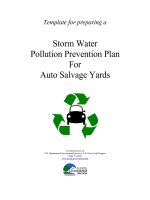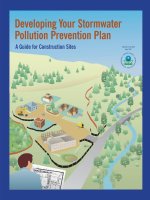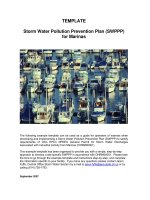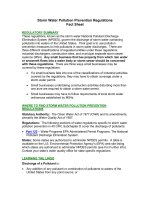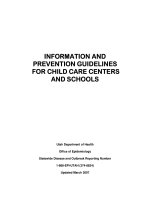Pollution prevention guidelines Controlled Burn: PPG28 docx
Bạn đang xem bản rút gọn của tài liệu. Xem và tải ngay bản đầy đủ của tài liệu tại đây (240.02 KB, 16 trang )
PPG 28 page 1
PPG28
July 2007
Environment Alliance - working together
pollution prevention guidelines
Controlled Burn: PPG28
These guidelines are jointly produced by the Environment Agency for England and Wales, the Environment and
Heritage Service for Northern Ireland, and, the Scottish Environment Protection Agency, referred to here as we,
or us.
This guidance will help you decide when and how to use a controlled burn as part of a fire fighting strategy to
prevent or reduce damage to the environment. You should consider this guidance on a site by site basis when
developing an incident response plan for your site. Contact us if you need further advice.
Following these guidelines doesn’t remove your responsibility to comply with the law and prevent pollution
from your activities. Causing or allowing pollution is a criminal offence: compliance with this or any guidance
isn’t a defence You should make sure that the references to other sources of guidance are still current; use
updated guidance if it exists.
1. Introduction
a) Our Pollution Prevention Pays - Getting your site right – good practice guidance; (Reference 1) gives basic
advice on pollution prevention. Further information on how to manage run-off generated in a fire (‘firewater’)
and major spillages is available in PPG18 (Reference 2) and CIRIA Report 164 (Reference 3). Guidance on
how to plan a response to a pollution incident is in PPG21 (Reference 4).
b) This document deals with using a ‘controlled burn’ to prevent or reduce water and air pollution from
firefighting activities at industrial and commercial sites.
It provides guidance on:
i) identifying sites where there is a risk of pollution following a fire
ii) circumstances where a controlled burn could be used as part of an on-site plan for dealing with
pollution incidents or during an actual incident to minimise impact on public health and the
environment
iii) points to consider when deciding whether such a strategy is appropriate
c) In this guidance, a controlled burn is an operational strategy where the application of fire fighting media
such as water or foam is restricted or avoided, to minimise damage to public health and the environment.
The strategy would normally be used to try and prevent water pollution by contaminated firewater. It can
also reduce air pollution due to the better combustion and dispersion of pollutants. But it may also have
adverse impacts such as allowing or increasing the formation of hazardous gaseous by-products.
d) When applying this guidance the protection of people must always take precedence over environmental
concerns.
PPG 28 page 2
2. Who should read this?
a) The guidance is aimed at:
i) site operators to help them determine if their premises pose a risk to the environment in the event
of a fire and if they do whether they should include a controlled burn within an agreed pollution
emergency response plan for their site
ii) the Fire and Rescue Service
iii) other parties who may be involved in planning for or dealing with such incidents, for example
local authorities, the Health and Safety Executive, public health officials and insurers/
underwriters
b) This guidance also contains information that might be of use to those dealing with fires at agricultural
premises or fires occurring during the transport of dangerous goods (Reference 5 & Reference 6).
c) This guidance supplements, but does not replace, any statutory requirements for sites controlled under
the Control of Major Accident Hazards Regulations, the Pollution Prevention and Control Regulations or
the Environmental Protection Act 1990. Further guidance for the operators of such sites on the
circumstances where a controlled burn should be considered, should be sought from the appropriate
regulator.
d) The risk assessment procedures recommended in this guidance should be applied in a proportionate
manner to the risks involved.
e) This guidance does not apply if you are involved with:
i) storing radioactive materials/wastes covered under the Radioactive Substances Act 1993
ii) fire fighting using:
• wholly non-aqueous agents, e.g. dry chemicals, vaporising liquids, gases
• aqueous agents such as water and foam when used in a portable extinguisher
iii) fires that are deliberately set and controlled to manage vegetation such as muirburns
iv) fire fighting for fire research and for testing fire extinguishing agents
3. Impacts of fire
a) The risks
Many industrial and commercial sites have the potential to cause significant environmental harm and to
threaten water supplies and public health in the event of a fire. This includes sites that:
i) store, use or process toxic and/or polluting substances such as many chemicals, oils, food and
beverage products
ii) contain hazardous materials such as asbestos within the fabric of the building
iii) contain or store materials which would give rise to hazardous breakdown products in the event of
a fire, e.g. toxic smoke from burning plastic
Appendix 1 gives examples of the types of sites and activities which are likely to pose a hazard.
A fire at sites like these can give rise to severe pollution due to:
i) firewater run-off: which can transport pollutants into drainage systems, rivers, groundwaters and
soil
ii) toxic smoke plumes and other airborne pollutants: which can cause both short and long term-
term adverse effects on health and the environment
iii) thermal radiation: which can harm people and the environment
PPG 28 page 3
The impacts of contaminated firewater run-off may be immediate and long-term. If groundwater is
polluted, the effects may last for decades. The legal consequences and clean up-operations can also
be very costly. We therefore encourage operators to develop incident response plans that prevent and
mitigate pollution.
b) Identifying ‘At Risk Sites’
Sites and activities will only pose a risk to people and the environment if the three components shown
below are present.
Site operators should undertake an assessment of the risk that their site poses by using a simple risk
screening assessment, as illustrated in Appendix 2.
c) How to reduce risk?
Where the risk screening assessment shows a high or medium risk of pollution from firefighting, site
operators, in liaison with the Fire and Rescue Service, other stakeholders and us, need to consider ways of
reducing the risk to an acceptable level.
There are four main ways to reduce risk and one or more of these may be employed at any given site:
i) Prevention Give the highest priority to preventing the fire in the first place, for example by
segregating or controlling sources of ignition
ii) Detection Make sure that, if a fire does start, it is detected and tackled as quickly as possible.
The fitting of automatic detection and protection systems such as sprinklers is one way of doing
this. Site operators should seek advice on such systems from their insurers and the Fire and
Rescue Service
iii) Containment By installing facilities for containing firewater such as bunds, storage lagoons or
chambers, shut-off valves and isolation tanks or areas. More information on firewater
containment is available in Reference 2 and Reference 3
iv) Mitigation Plan with the Fire and Rescue Service suitable fire fighting strategies, such as:
• reducing the amount of firewater generated: using sprays rather then jets
• recycling firewater where this is not hazardous
• a controlled burn where it is safe to do so. In cases where action is required to prevent
the fire spreading, for example the application of cooling water to the areas around the
storage tanks, care should be taken to ensure 1) this water does not become a
pollutant or 2) the cooling process does not cause significant increases in air pollution
4. Deciding how to reduce risk
The decision on which strategy or combination of strategies to adopt can be made either as part of
an agreed pollution incident response plan guided by a full risk assessment or during an incident, based
on a dynamic risk assessment.
a SOURCE, e.g.
contaminated
firewater run-off,
toxic smoke plume
a RECEPTOR
e.g. a river,
groundwater,
local populations
a PATHWAY
e.g. surface drains,
permeable ground,
air
PPG 28 page 4
a) Planned and agreed
This is our preferred option, as it is based on a full assessment with all the facts available and the
agreement of all interested parties. Such an assessment should take into account:
i) the scale and nature of the environmental hazards presented by the site and the activities that
take place on it
ii) the risks posed to people and the environment and the extent of the possible damage
iii) the difficulty in deciding and justifying the adequacy of the risk management measures adopted
iv) the local topography and different meteorological conditions and fire scenarios that could be
reasonably expected at the site
References 3 and 7 give examples of risk assessment methodologies that might be suitable and reference
8 gives information on our approach to risk assessment.
However you carry out the risk assessment, it should be tiered and proportionate. You should select the
most appropriate response by seeking guidance from one of our local offices, the Fire and Rescue Service,
the Health and Safety Executive, public health authorities and insurers.
b) During an incident
Where a fire has taken hold, no emergency plan exists and there is no, or inadequate, secondary
containment then the only options to protect people and the environment are to extinguish the fire and
deploy emergency containment measures to control run-off or use a controlled burn to reduce run-off and/
or air pollution.
The decision on which of these options to use will need to be taken quickly by the Fire and Rescue
Service Incident Commander, based on a dynamic risk assessment. The first step will be to assess the
impacts of firefighting on air quality and the ability/capacity to contain any firewater. Where firefighting
is likely to exacerbate air pollution and/or it is not possible to contain firewater, then a controlled burn
should be considered.
5. Is Controlled Burn appropriate?
The decision to employ a controlled burn will rest with the Fire and Rescue Service’s Incident Commander
who will need to consider the factors below before deciding whether it can be safely employed. When
doing so, wherever possible, this should be in consultation with other stakeholders and us.
a) Life and health
Preventing fatalities, injuries and adverse health effects to people will always override environmental and
other considerations such as the protection of property.
b) Spread of fire
Where offensive fire fighting is required to stop a fire escalating, a controlled burn will not initially
be appropriate and efforts should instead be made to contain firewater. Once the risk of escalation has
been minimised, there are no risks to people and it is not possible to contain firewater and/or this is the
best option to minimise air pollution, then a controlled burn might be considered.
c) Is a controlled burn the best environmental option?
You will need to consider the short and long term effects on air, land and water quality. There are several
environmental risk assessment tools to help with this. Most contain common features and are based on
the relationship between the source, pathway and receptor.
PPG 28 page 5
Appendix 3 gives a table highlighting the key stages of an environmental risk assessment. The amount of
information needed and the potential complexity of any decision reinforces the advantages of planning.
d) The legal consequence of allowing fires to burn
In England and Wales, the Fire and Rescue Service Act 2004 (Reference 9) and, in Scotland, the Fire
`(Scotland) Act 2005 (Reference 10) place no legal duty on Fire and Rescue Authorities to extinguish fires.
Their duty is only to provide for extinguishing fires and protecting life and property in the event of a fire.
For Scotland, the ‘Fire (Scotland) Act 2005’, “extinguishing”, in relation to a fire, includes “containing and
controlling”, giving Incident Commanders the option of using a controlled burn.
The decision on how to conduct fire fighting operations is governed by the principles of common law
relating to reasonableness. In practice, this means there are likely to be circumstances such as the
protection of public water supplies, where it would be reasonable for the Fire and Rescue Service Incident
Commander to decide to cease - or limit - firefighting operations because the consequences of continuing
would be worse than the destruction of property.
e) The importance of the building
Certain buildings have a particularly high architectural, cultural, historical or strategic significance. It
is unlikely that such a building would be used to store significant quantities of polluting substances and
pose a high risk in the event of a fire. Where they do, the health and environmental benefit of a controlled
burn, if this is considered to be the least damaging option, must be weighed against the value of the
building. The decision will need to be taken individually, with advice from the appropriate conservation
body.
Where the building is considered to be of high value and fire fighting poses a high risk to the
environment, then firewater containment should be employed.
f) The requirements of the site operator and insurer
The requirements of the site owner, tenants and sub-tenants and their insurers should be considered.
When doing so, remember that clean-up costs might exceed the value of the building and lost product
and production. And, in the event of pollution, prosecution of the operator is more likely if appropriate
pollution prevention measures have not been taken. The decision to employ a controlled burn might also
be considered a material fact by the site insurer and consequently influence whether or not they provide
insurance cover.
The decision making process will be far easier if these parties have taken an active role in developing
the emergency response plan. In a fire, where no plan exists, decisions will have to be taken quickly by
the Fire and Rescue Service Incident Commander and our officers, based on operational priorities. This
situation will be exacerbated if it proves difficult to contact the site operator, so we strongly recommend
that site operators provide a readily available 24 hour contact number.
g) Public perception
Although the general public should not be involved in dealing with the fire, the emergency services
should keep them informed. This should include an explanation of why a controlled burn is being
employed.
PPG 28 page 6
h) When to use a controlled burn
Below is a summary of the likely situations where a controlled burn might or might not be appropriate.
Controlled burn is inappropriate Controlled burn might be appropriate
A controlled burn will increase the risk to people People are not at risk, or a controlled burn will reduce
the risk to people
There is a high success forecast for extinguishing the
fire with minimal impact on human health and/or the
environment
There is a low success forecast of extinguishing the fire
There is a high probability of the fire spreading
extensively or to high hazard areas (*)
Fighting the fire with other techniques would pose a
significant risk to fire fighters (*)
Important buildings are involved (**) Property is beyond salvage
Fire conditions, meteorological conditions and/or local
topography are inappropriate e.g. plume grounding in
a populated area
Fire conditions, meteorological conditions and the
local topography are appropriate for minimising the air
quality impacts
Firewater run-off will drain to an area of low
environmental sensitivity or firewater is not polluting
(***)
Firewater run-off would damage an area of high
environmental sensitivity (***)
Firewater can be contained Firewater run-off would affect potable supply intakes
and other abstractions
Firewater run-off could impair the operation of a
Sewage Treatment Works
(*) In such a situation it may be possible to employ a controlled burn once the fire is under control, or
alternatively employ other methods to contain the firewater.
(**) See section 5e.
(***) See Appendix 4 for further guidance on identifying environmental sensitivity.
6. Actual response strategy
a) Production of Pollution Incident Response Plan
If the risk assessment has shown that a controlled burn can safely be employed, is the least damaging
health and environmental option and the Fire and Rescue Service is agreeable, the strategy should be
incorporated into a pollution incident response plan for the site.
This response plan should be developed with stakeholders and cover both the event and post event
phase. As well as the actual arrangements for mitigating pollution it should also cover monitoring
arrangements both on and off site.
The response plan may be part of a formal plan required as:
• part of regulations such as the Control of Major Accident Hazards and Pollution Prevention and Control
• an industry inspection scheme such as the British Agrochemical Standards Inspection scheme
(reference 11)
• an environmental management system (e.g. ISO14001)
Reference 4 gives further guidance on preparing such plans
PPG 28 page 7
b) In the event of fire
The actual response will depend on the circumstances that face the Fire and Rescue Service’s Incident
Commander. The final decision will always rest with that Commander.
7. Communicating the decision
The decision to employ a controlled burn, whenever practicable, must be conveyed to all the interested
parties: the site operator and insurers, health officials, us and, in many cases, the press and public.
8. References
1. Pollution Prevention Pays. Getting Your Site Right – industrial and commercial pollution prevention
2. PPG18 : Managing firewater and major spillages
3. Design of Containment Systems for the Prevention of Water Pollution from Industrial Incidents. CIRIA
Report 164. ISBN 0 86017476 X Construction Industry Research and Information Association. (CIRIA)
4. PPG21 : Pollution incident response planning
5. PPG 22 : Dealing with spillages on highways
6. The Carriage of Dangerous Goods and Use of Transportable Pressure Equipment Regulations 2004. TSO.
ISBN 0110490630. />7. Environmental Impact of Controlled Burns, Technical Report P388. ISBN 1, 85705 4148.
Environment Agency. /> 424004cc02b39aec273fc0a802960680/Product/View/GEHO1004BIFU&2DE&2DP
8. Guidelines for Environmental Risk Assessment and Management. /> risk/eramguide/index.htm
9. The Fire & Rescue Service Act 2004. TSO. ISBN 0 10 542104 9.
/>10. The Fire (Scotland) Act. 2005.TSO. ISBN 0 10 590078 8.
/>11. Inspection and Approval of Agrochemical Stores by Environmental Protection Officers and Fire Officers in
connection with BASIS Registration LTD. BASIS (Registrations) Limited, 2000, telephone 01335 343945
Reference 1,2,4 & 5 are available free of charge from our offices or on our web sites
i) www.environment-agency.gov.uk/ppg
ii) www.sepa.org.uk/guidance/ppg/
iii) www.ehsni.gov.uk/environment/waterManage/waterPollution/publications.shtml
PPG 28 page 8
9. Other useful sources of information
1. Model Code of Safe Practice in the Petroleum Industry : Part 19. Fire Precautions at Petroleum Refineries
and Bulk Storage Installations. ISBN 0471943282
2. Waste Management The Duty of Care: A Code of Practice. ISBN 0 11 753210 X. HMSO. ra.
gov.uk/environment/waste/management/doc/pdf/waste_man_duty_code.pdf
3. A Guide to the Control of Major Accident Hazard Regulations (COMAH) 1999 (as amended), L 111. ISBN
071766175X . HSE Books, telephone 01787 881165
4. Guidance on the Environmental Risk Assessment Aspects of COMAH Saftey Reports: COMAH Competent
Authority. ( Gui
dance on the Environmental Risk Assessment Aspects of COMAH reports’)
5. Storage of flammable liquids in containers, HSG 51. HSE Books, ISBN 07176 14719, telephone 01787
881165
6. Chemical Warehousing – the storage of packaged dangerous substances, HSG 71. HSE Books, ISBN 07176
14840, telephone 01787 881165
7. Storage of flammable liquids in tanks, HSG 176. HSE Books, ISBN 07176 14700, telephone 01787 881165
8. Timber Treatment Installations 2003: Code for Safe Design and Operation. The Environment Agencies
and British Wood Preserving and Damp Proofing Association, 2003. Telephone 01332 225100.
/>9. Guidance on assessing the environmental effect of fire effluents. Working Document ISO/TC 92/SC 3N7
10. The ecotoxicity of firewater runoff. New Zealand Fire Commission, 2001. ISBN 0-908920-61-1
/>11. The Fire and Rescue Service Manual – Environmental Protection. TSO To be published 2007.
PPG 28 page 9
Appendices:
Appendix 1
Sites/activities of particular concern
These include, but are not limited to:
Sites regulated under the Pollution Prevention and Control Regulations 2000, as amended and
Environmental Protection Act 1990
Establishments regulated under the Control of Major Accident Hazards Regulations 1999
Sites storing/processing hazardous waste as defined in the Hazardous Waste Regulations 2005 in
England, Wales and Northern Ireland, or ‘special waste’ in Scotland - as defined in the Special Waste
Regulations 1996 and in the Special Waste Amendment (Scotland) Regulations 2004
Timber treatment plants and timber stores
Metal platers and surface finishers
Large DIY superstores and garden centres
Agrochemical stores – at end user premises, sale and supply premises and third party warehouses
Pesticide manufacture/storage premises
Regulated waste movement and disposal
Plastic manufacturing and recycling sites
Chemical, petrochemical, pharmaceutical and veterinary product manufacture, distribution and storage
facilities
Petrochemical refineries, petroleum import, distribution and storage facilities
Paint, coatings and ink manufacture, distribution and storage facilities
Paper and pulp sites
Used tyre and waste fridge storage facilities
Farm buildings
Composting facilities
Landfill sites
The transport of materials covered by The Carriage of Dangerous Goods and Use of Transportable Pressure
Equipment Regulations 2004
Sites where hazardous materials may be formed in the event of a fire, e.g. from burning plastic
Sites producing and storing substances not hazardous to human health but with high oxygen demand.
PPG 28 page 10
Examples include:
• Dairies
• Soft drink manufacturers
• Distilleries and breweries
• Cereals and grain producers
• Sugar/molasses producers
• Cold stores and food processing (human and pet) facilities
• Associated bulk storage warehouses
Appendix 2
Risk screening assessment process
The process typically involves:
1. identifying and assessing potential links between the sources, pathways and receptors
2. assessing the likelihood and magnitude of any potential harmful effects
Examples of the criteria to consider in such an assessment include:
• type of site/activity
• type and quantity of environmentally hazardous substances
• incident history
• potential effects on air, land and water under both controlled burn and extinguish conditions
• whether adequate containment and/or other control mechanisms exist
• potential for dilution, dispersion and attenuation from release to reaching receptor
• location of receptors (see Appendix 4)
• sensitivity of receptors (see Appendix 4)
This initial assessment will usually be qualitative. It should be based on the operator’s experience and judgement
of the risks posed by the facility, supported if required by our advice on the environmental sensitivity of the site.
See Appendix 4 for further guidance. The table below using a pesticide store in a remote rural location shows how
to carry out such an assessment.
Once the initial screening exercise has been undertaken, the site operator should prioritise the risks so that any
more detailed risk assessment can focus on the areas of highest risk, followed by those of medium and then low
significance.
We recommend site operators discuss with us which priority areas require more sophisticated assessment.
PPG 28 page 11
Site operators must be wary of dismissing a risk too easily because it appears that one of the Source - Pathway-
Receptor components is missing. For example, the inclusion of secondary containment systems such as a bund
(preventing a pathway) may reduce the risk. But it will not eliminate it because the bund might fail. Such a failure
could occur if adding the firewater exceeded the capacity of the bund or the bund cracks in the heat or the jointing
material fails. In the case of hydrocarbon fires, this could even escalate the fire as firewater may fill a bund and
displace a flammable liquid. This situation could be overcome by:
• a controlled burn
• an increase in the capacity of the bund to allow for firewater
• a design of bund that allows firewater to escape whilst the flammable liquid remains contained. This
should not include the installation of any valves in the bund
Similarly, site operators might exclude the air pathway because the pesticide store is in a remote area. But certain
fire, meteorological and topographical conditions may cause the plume to ground in a populated area and have a
significant impact on health. And the deposition of the combustion products in rural areas might contaminate the
food chains.
Please refer to following table on next page.
PPG 28 page 12
Example of rapid risk screening assessment – pesticide store in a rural location
Data and information Judgement Action
What is at
risk? What
do I wish to
protect?
The
substance,
agent or
process with
potential to
cause harm
What might
go wrong or
what harmful
consequences
might follow?
How might
the source of
the hazard
reach the
receptor?
How might the
receptor come
into contact
with the
source of the
hazard?
How likely is
this contact
or exposure?
How severe
are the
consequences
of harm if
exposure
occurs?
What is the
magnitude of
the risk?
On what did I base my judgement
about the magnitude of the risk?
How can I best manage
the risk?
Risk
significance
once risk
management
measures are
in place
Receptor
Source of
Hazard Harm
Transport
mechanism Pathway
Probability of
exposure Consequences
Magnitude of
the risk Justification for magnitude Risk management Residual risk
Residents/
bystanders in
areas where
smoke plume
could ground
Generation of
toxic smoke
plume
Respiratory
irritation, asthma,
lung and other
diseases.
Grounding of
smoke plume
Inhalation
of airborne
smoke,
particulates,
and toxic
chemicals
Low/Medium High Medium/High
- High
The likelihood of people being
exposed is low/medium because
the site is situated in remote rural
location away from centres of
population. However certain fire
and meteorological conditions
(about 40% of the year) will lead
to plume grounding in Towns A, B
and C, which are about 4km away.
The consequence is high because
the predicted concentrations of
pollutants can exceed the health
limits.
Enhanced fire
prevention systems.
Use of controlled
burn restricted if
meteorological
conditions are
unfavourable. In such
cases consider issuing
warning to residents
of Towns A, B and C
to close doors and
windows and stay
inside.
Very Low
Agricultural
lands
Consumption
of food that is
contaminated
with
carcinogenic
air pollutants
Pollutants such as
dioxins, furans,
PCBs enter the
food chain
Deposition of
air pollutants
Deposition of
air pollutants.
Crops may
become
contaminated.
Animals may
graze on
contaminated
land.
High/Medium Low Low/Medium The likelihood of contaminating
agricultural lands is high/medium
because there are four farms
within 1.5km of the pesticide
store. The consequence is low
because the predicted deposited
flux is low, the consumption
of food contaminated with the
combustion products does not
cause significant acute or chronic
health impact.
Enhanced fire
prevention and
secondary containment.
Use of controlled burn
if containment capacity
exceeded.
Consider restrictions on
crops including animal
feeds in the event of
any fire.
Very Low
Receiving
river,
groundwater
Run-off likely
to contain
toxic and
persistent
pesticides.
A high BoD
likely if foam
is used
Closure of local
groundwater
drinking
water source.
Degradation of
water quality
in watercourse.
Death of aquatic
fauna and flora
Contaminated
firewater run-
off draining
to site
surface water
drain and
soakaways
Direct
discharge from
drain to river
and infiltration
of firewater to
groundwater
below site
High High High Limited secondary containment.
Site situated in groundwater
Source Protection Zone and
adjacent to high quality
watercourse
Enhanced fire
prevention and
secondary containment.
Use of controlled
burn if containment
capability exceeded
and metreological
conditions are
favourable
Low
PPG 28 page 13
This table is only an example. In similar sites, other receptors could include important wildlife sites, fisheries,
businesses and amenity areas
Probability of exposure is the likelihood of the receptors being exposed to the hazard. Example definitions:
High exposure is probable: direct exposure likely with no/ few barriers between hazard source and
receptor;
Medium exposure is fairly probable: feasible exposure possible - barriers to exposure less controllable;
Low exposure is unlikely: several barriers exist between hazards source and receptors to mitigate against
exposure:
Very Low exposure is very unlikely: effective, multiple barriers in place to mitigate against exposure.
The consequences of a hazard being realised may be actual or potential harm. Example definitions:
High the consequences are severe: sufficient evidence that short- or long-term exposure may result in
serious harm e.g. Category 1 pollution incident
Medium consequences are significant: sufficient evidence that exposure to hazard may result in damage that
is not severe in nature and reversible once exposure ceases (e.g. irritant);
Low consequences are minor: damage not apparent though reversible adverse changes may occur;
Very Low consequences are negligible: no evidence of adverse changes following exposure.
Magnitude of the risk is determined by combining the probability with the potential consequences. Use the
designations alongside this column and the matrix below to categorise as high, medium, low or very low.
H L M H H
M L M M H
L L L M M
VL VL L L M
VL L M H
consequences
High risks require additional assessment and active management; medium risks require additional assessment and may
require active management/monitoring; low and very low risks require periodic review.
probability
PPG 28 page 14
Appendix 3
Common features of an Environmental Risk Assessment
Although there are a number of environmental risk assessment techniques, most will contain certain common
features and will be based on the relationship:
Impact is proportional to dose x sensitivity
The dose is determined by the concentration of the pollutant, mass flow rate and exposure period. The sensitivity
depends on the location of the site and the characteristics of the receptors.
The assessments should include impacts on: human health, the water environment, air pollution and the ground,
including deposition from the air.
The key stages in a full risk assessment of an accidental release of contaminants are summarised in the following
Table:
Step
Stage Information
1
Identify the environmental hazard The inherent hazards of the released substance, taking into
account its chemical and physical properties.
2
Estimate the potential scale of the
release of pollutant(s)
The amount and rate of release of each substance in the fire
3
Estimate the scale of the hazard This is a function of the previous two factors
4
Estimate the likely rate of transfer
to the receptor(s)
Predict the dispersion and deposition of the release (sometimes
by modelling). This must take into account:
• Duration of the release
• Flow rate through this pathway, e.g. is there a pathway
through fissured rocks to an underlying aquifer?
• Distance and direction to receptor e.g. is smoke blowing
towards or away from residential area?
• Differences in meteorological conditions (e.g. atmospheric
stability) and nature of the fire.
• Mitigating effects of dilution or dispersion, e.g. will a
river’s flow rate or meteorological conditions sufficiently
dilute contaminants?
5
Estimate the potential dose The amount of pollutant the receptors receive. The dose is a
function of the amount and the exposure period.
6
Estimate the sensitivity of the
receptors
The degree of sensitivity of the receptors to the released
substances.
7
Estimate the impact What are the consequences on human health and the
environment? The impacts of the incident will be a function of
dose and sensitivity.
• Appendix 4 gives examples of some of the features that we would consider when determining the
environmental sensitivity of the site. Our local offices may be able to provide more site specific
guidance.
• It also recognises that some of the information required may be difficult to obtain, for example the
amounts and rates of releases of each substance in the fire and the dispersion and deposition of the
releases. Where information is not available, estimates will need to be made.
PPG 28 page 15
Appendix 4
4.1 Features to help determine the sensitivity of the receiving water environment
The sensitivity of the receiving environment for any contaminated firewater run-off is highlighted as one of
the factors that should be considered when carrying out the Rapid Risk Screening Assessment process and, if
necessary, a full environmental risk assessment.
Listed below are examples of what we would consider when determining the sensitivity of the site:
High sensitivity
• situated over a major aquifer
• within a designated Groundwater Source Protection Zone
• within 250m* of any other well, spring or borehole used for potable abstraction
• situated above a shallow water table (<2m) and with free draining ground
• situated above a fissured rock, e.g. chalk, posing risk of rapid flow to groundwater or surface water
• less than 5km upstream of a surface water potable or private drinking water abstraction point
• less than 5km upstream of an important surface water industrial or agricultural abstraction point
• firewater would affect a salmonid fishery and/or a national or internationally important conservation site
• firewater would affect a site of high amenity value
* This figure is useful in an emergency but should really be refined, based on more detailed risk assessment as
part of the planning process.
Medium sensitivity
• situated over a minor aquifer
• between 5km-20km upstream of a surface water potable or private drinking water abstraction point
• between 5km-20km upstream of an important surface water industrial or agricultural abstraction point
• firewater would affect a coarse fishery or locally important conservation site
• firewater would affect a site of moderate amenity value
Low sensitivity
• situated over a non aquifer
• outside any designated Groundwater Source Protection Zones
• situated above deep water tables
• situated on low permeability ground such as clay
• more than 20km upstream of a surface potable or private drinking water abstraction point
• more than 20km upstream of an important surface water industrial or agricultural abstraction point
• firewater would have limited impact on fish populations or wildlife
• firewater would affect a site of limited amenity value
4.2 Features to help determine the sensitivity of the receiving air environment
The sensitivity of the receiving environment for the combustion products of a fire is highlighted as one of
the factors that should be considered when carrying out the Rapid Risk Screening Assessment process and,
if necessary, a full environmental risk assessment. The sensitivity depends on the scale and nature of the
combustion products (e.g. hazardous substances) of the fire.
PPG 28 page 16
Listed below are examples of what we would consider in a small fire (e.g. a road tanker) when determining the
sensitivity of the site:
High sensitivity
• situated less than 1km from schools, hospitals, built-up areas of more than 500 people over a non aquifer
Medium sensitivity
• situated 1km to 2km from schools, hospitals, built-up areas of more than 500 people
Low sensitivity
• situated more than 2km from schools, hospitals, built-up areas of more than 500 people
Would you like to find out more about us, or about your environment?
Then call us on incident hotline floodline
08708 506 506 (Mon-Fri 8-6) 0800 80 70 60 (24hrs) 0845 988 1188
Environment Agency
www.environment-agency.gov.uk
HEAD OFFICE
Rio House
Waterside Drive
Aztec West
Almondsbury
Bristol BS32 4UD
Tel: 01454 624 400
Fax: 01454 624 409
Scottish Environment Protection Agency
www.sepa.org.uk
CORPORATE OFFICE
Erskine Court
The Castle Business Park
Stirling FK9 4TR
Tel: 01786 457 700
Fax: 01786 446 885
Environment and Heritage Service
www.ehsni.gov.uk
HEAD OFFICE
17 Antrim Road
Lisburn
County Antrim BT28 3AL
Tel: 028 9262 3100
Fax: 028 9267 6054
Environment first: This publication is printed on paper made
from 100 per cent previously used waste. By-products from
making the pulp and paper are used for composting and fertiliser,
for making cement and for generating energy.
PMHO1005BJIT-E-E


